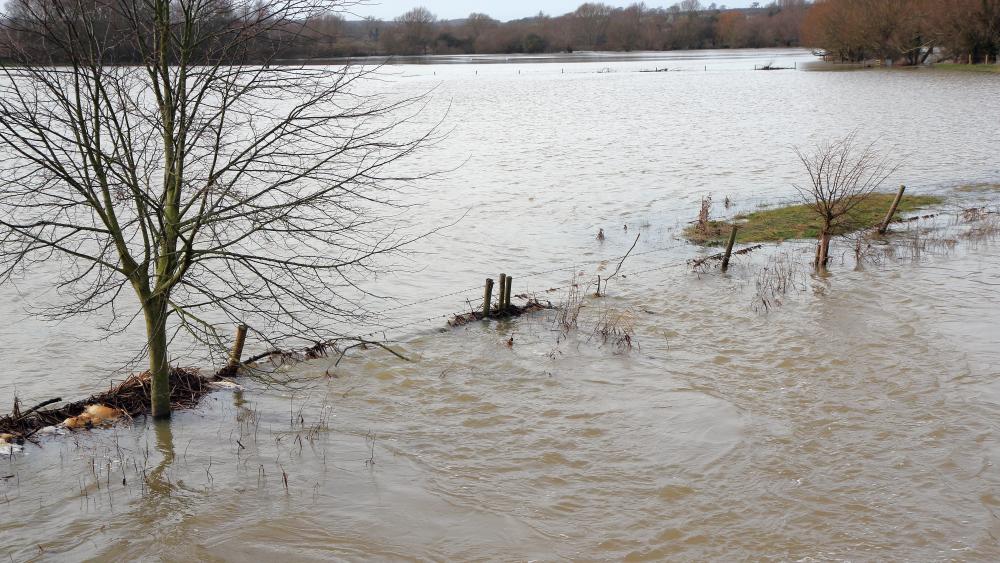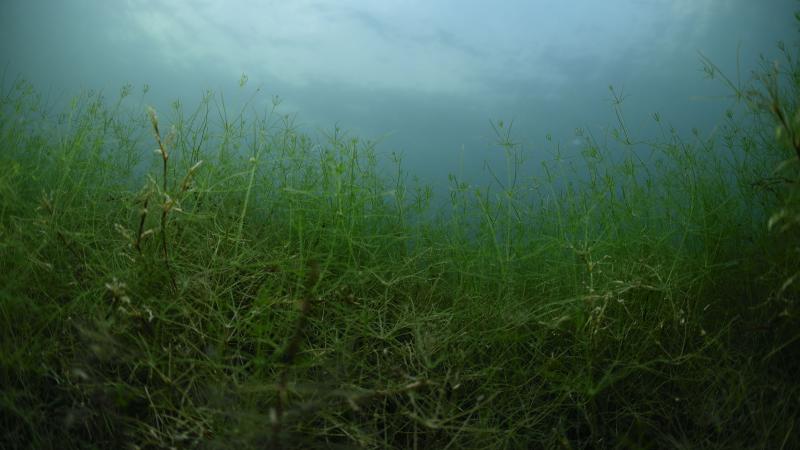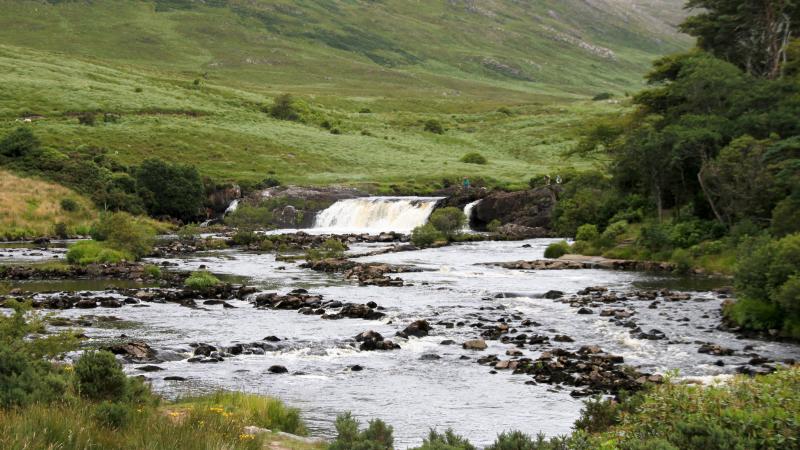
IGB researchers recommend prioritising the implementation of cost-effective and multifunctional near-natural flood protection. | Photo: © shutterstock_2319474775
For most people, a river ends where the water meets the land – at the embankment. And yet rivers are much wider than that: in times of flooding, natural floodplains are an integral part of the river. The riverbeds themselves were also originally wider, with water flowing in several arms and around many islands, as is still the case with the Loire and the Vistula, for example.
Only 32 per cent of such floodplains still exist in Germany. The remaining 68 per cent have been separated from the rivers by dyke construction, then drained and used for agriculture or settlements.
“The construction of dykes and drainage, which was useful at the local level, has led to whole regions being more susceptible to flooding due to their widespread implementation. In the moorlands of Lower Saxony, for example, drainage has caused the ground surface to sink by one to two metres,” explained IGB researcher Dr Martin Pusch. Thereby, potential flood heights have been increased in wide areas.
Floods as a natural event
“Floods are natural events that have significantly contributed to the unique biodiversity in riverine landscapes and to the resilience of these ecosystems over thousands of years. They are even a prerequisite for vital functions - such as groundwater recharge. For more sustainable flood protection, the focus should therefore not only be on technical measures, but increasingly on nature-based solutions,” reported Professor Dr Sonja Jähnig, Head of Department at IGB and Professor at Humboldt-Universität zu Berlin.
It has been the construction of settlements and infrastructure in the floodplains that has led to the emergence of major material and personal risks from what was actually a natural phenomenon. River regulation and the construction of dykes too close to rivers, as well as large-scale drainage, cause flood waves to swell higher and faster. At the same time, anthropogenic impacts such as climate change, surface sealing and compaction as well as stream channelization are leading to increased flood frequency, flood height and flow velocity.
Limited protection provided by dykes and retention basins
Technical flood protection systems cannot provide absolute protection. If rain and flood events are more severe than design criteria, they quickly become a problem. "Predominantly technically oriented and often unsustainable flood protection is increasingly reaching its limits because it bears considerable residual risks, creates new risks downstream and also damages the environment," explained the IGB researcher.

© David Ausserhofer/IGB
"We need to get away from the idea that a river just transports water somewhere and instead focus on these ecosystems providing many different services."
Prof Dr Sonja Jähnig
Technical flood defences not only have a major impact on the structure of water bodies, they are also expensive, usually inflexible and difficult to adapt to the increasing flood events caused by climate change. In addition, valuable habitats for many animal and plant species in and around water are lost – and with them many benefits for us humans. “We therefore need significantly more flood protection concepts to be implemented that create multiple benefits for people and the environment,” advised Jähnig. “We need to get away from the idea that a river just carries water somewhere, and instead endeavour to ensure that these ecosystems provide a wide variety of services.”
Natural flood protection is an important part of the solution
Instead of relying solely on structural measures such as dykes or artificial retention basins, more use should be made of nature-based solutions (NbS). These are usually multifunctional, i.e. they serve several legal, social or economic objectives at the same time – in the case of floodplains, for example, climate mitigation and adaptation, recreation, nature conservation or biomass production. Actions such as revitalising rivers, floodplains, wetlands, moors and forests, or unsealing land surfaces, improve water retention in the landscape, making it more resilient to floods – but also to droughts and dry spells.
© David Ausserhofer/IGB
"Protecting fields and farmland from flooding increases the risk of flooding for cities, settlements and important infrastructure. This is why dykes should be moved back and additional floodplains created."
Dr Martin Pusch
Technical flood protection measures such as dykes, on the other hand, should primarily be limited to residential areas and infrastructure, but should not be used to protect agricultural land. “Protecting fields and farmland from flooding increases the risk of flooding for cities, settlements and important infrastructure,” explained Martin Pusch. “Therefore, dykes should be moved back in order to create additional floodplains. Agricultural land located in the floodplains would then no longer be protected, but could still be used as pastureland or for the production of biomass – for example by growing crops that require only little fertiliser.”
In the Netherlands, which is a leader in hydraulic engineering since long, this principle is being implemented on a large scale as part of their "Room for the River" programme. In Germany, on the other hand, relatively few dyke relocations are carried out, meaning that the active floodplain area could only be increased by 0.1 per cent per year between 2009 and 2020. “Most of the money in Germany has been invested in raising and reinforcing dykes,” criticised Pusch.
National Flood Protection Programme falls short of expectations
Following the severe flooding in 2013, the federal and state governments have adopted a National Flood Protection Programme (NHWSP) for Germany to coordinate and accelerate natural flood retention. Its full implementation could reduce flood levels by 10 to 50 cm for many of Germany's large rivers.
“Unfortunately, however, two-thirds of the flood retention is planned to be achieved through new polders, and only one-third through near-natural flood retention such as dyke relocations,” said Pusch. Of the 168 spatially significant partial and individual measures of the NHWSP, 66 are in the conception phase (39 per cent), 46 (27 per cent) in the preliminary planning phase, 18 (11 per cent) in the approval or award phase and 26 (15 per cent) in the construction phase..
The IGB researchers therefore recommend prioritising the implementation of cost-effective and multifunctional near-natural flood protection. Dyke relocations provide a much broader range of ecosystem services than the creation of technically controlled polders that are rarely flooded, and near-natural flood protection works independently of the official information and decision-making chain. The land required for these dyke relocations should be reserved in regional and land-use planning. Affected farmers could be compensated through land pools and land consolidation programmes.
“Only with such a holistic approach can we meet the challenges of flood protection in the long term and at the same time preserve the natural habitats along our watercourses,” concluded floodplain expert Martin Pusch, adding: “Numerous scientific studies prove that it makes sense to conserve floodplains and restore their functions – not only for flood protection, but also because of their ability to reduce nutrients, their importance in the carbon cycle and for the conservation of biodiversity.”
Further information on the topic
In 2022, German scientists, under the leadership of the Senckenberg Gesellschaft für Naturforschung (SGN), summarised in a policy brief how smart flood protection could look like and which advantages nature-based solutions in particular offer. The policy brief, to which IGB also contributed, recommends the revitalization of rivers and their floodplains, the rewetting of peatlands and transformation of German forests.
Ecological flood protection – which restores floodplains – is sensible, technically possible and economically efficient. Nevertheless, this approach is not yet being consistently implemented worldwide because the administrative and legal hurdles are high. This was shown in a study by IGB scientists who, together with other research institutions, analysed four floodplain restoration projects in Germany and the USA.
Riverine wetlands are not only important for flood protection, but also provide numerous services for our society, such as climate regulation, carbon sequestration, water filtration, food supply and recreational opportunities. A background document from the European conference “Riverine and coastal wetlands for biodiversity and climate – Linking science, policy and practice”, which was organised by BfN and ENCA in 2023, provides an overview.
The IGB experts will be happy to provide you with further information!







